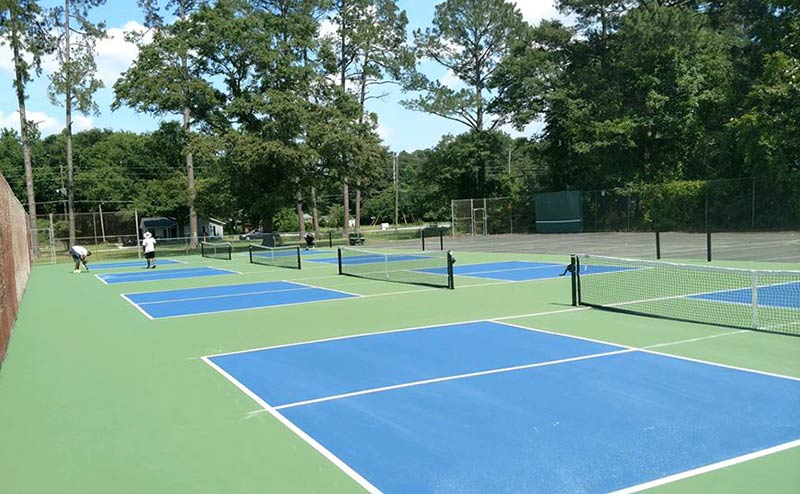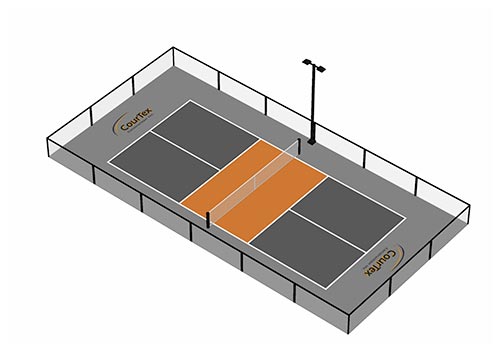Pickleball Court Construction-- Expert Installment for Your Desire Court
Pickleball Court Construction-- Expert Installment for Your Desire Court
Blog Article
Lasting Practices in Pickleball Court Building You Ought To Know
As the popularity of pickleball remains to rise, so as well does the demand for sustainable methods in court construction. This method not only addresses ecological issues however likewise improves the long life and performance of the courts. From picking green materials to executing reliable water drainage and energy-saving lights services, there are numerous strategies to take into consideration. Yet, the impact of these practices expands far past the court itself. Understanding how each aspect adds to an extra lasting future welcomes better expedition into the elaborate equilibrium between entertainment growth and environmental stewardship.
Selecting Eco-Friendly Products
Choosing green materials is a vital action in the building and construction of sustainable pickleball courts. The selection of sustainable products not just decreases ecological effect but additionally boosts the durability and efficiency of the court. Key products consist of recycled rubber for the surface area, which uses superb toughness and shock absorption while diverting waste from garbage dumps.
Furthermore, utilizing locally sourced materials decreases transport discharges and sustains regional economic situations. Pickleball court construction. As an example, making use of native hardwoods for secure fencing and seats can provide a sustainable visual while guaranteeing strength versus the elements.
Incorporating permeable products for court foundations can better add to sustainability by enabling all-natural water drainage and minimizing drainage. These selections not just protect regional ecosystems however also promote healthier play settings.
Efficient Water Drainage Solutions
While the option of environment-friendly materials is important, carrying out effective drainage solutions is just as critical for maintaining sustainable pickleball courts. Appropriate drainage not just shields the court surface area from water damages yet additionally minimizes erosion and drainage, advertising ecological stability.
Effective drainage systems can consist of absorptive paving, which permits water to infiltrate the ground as opposed to pooling on the surface. This minimizes the possibility of standing water, which can bring about mold and mildew and various other maintenance issues. In addition, integrating strategically placed drainage channels and swales can guide excess water far from the court location, making certain a completely dry having fun surface area and stopping soil erosion.
Using indigenous plant life in the landscape design around the courts can better enhance drainage by absorbing excess water and lowering runoff. These plants call for much less watering and advertise biodiversity, aligning with sustainable practices.
Additionally, it is important to frequently preserve the drain system to guarantee its lasting performance. This includes clearing up debris and monitoring for obstructions. By prioritizing efficient drainage solutions, pickleball court erectors can dramatically add to the sustainability and longevity of the center, inevitably profiting both players and the setting.
Energy-Efficient Lights Options
As the demand for pickleball proceeds to grow, integrating energy-efficient illumination alternatives into court design has actually become progressively essential for sustainability. Traditional lights systems usually take in excessive energy, adding to higher operational costs and environmental influence. Consequently, taking on modern-day, energy-efficient modern technologies is essential for both look at here brand-new building and constructions and improvements.
LED (Light Emitting Diode) lights stands apart as a top selection as a result of its longevity and power savings (Pickleball court construction). Compared to conventional illumination, LEDs utilize around 75% less energy and can last up to 25 times much longer, considerably minimizing upkeep prices. Additionally, the directional nature of LED illumination minimizes light air pollution, ensuring that illumination is focused on the court instead of bordering locations.

Lasting Surface Area Alternatives
Exploring sustainable surface area options for pickleball courts has gotten grip amongst builders and players alike. The emphasis on environmentally friendly materials not just aligns with the expanding ecological recognition yet additionally boosts the efficiency and toughness of the courts.
This material gives exceptional shock absorption, decreasing the threat of injuries for players while advertising sustainability. These ceramic tiles are simple to change and set up, and their versatility allows for numerous court configurations.
Natural turf courts are additionally becoming a sustainable selection, advertising biodiversity and reducing the heat island result. However, they require routine upkeep and water, which might not align with all sustainability objectives.

Water Preservation Methods

An additional efficient technique involves the setup of rain harvesting systems. These systems save and collect rain for use in keeping court surface areas and landscape design. This approach not only preserves potable water yet also lowers reliance on local resources.
Furthermore, using drought-resistant landscaping around the courts is necessary. Native plants need much less water and are much better adapted to neighborhood climate problems, therefore decreasing total water consumption. Furthermore, making use of reliable irrigation systems, such as drip watering, ensures that water is supplied straight to plant origins, reducing evaporation and waste.
Conclusion
Integrating lasting methods in pickleball court construction substantially contributes to environmental preservation and resource performance. By prioritizing these practices, the construction of pickleball courts can straighten with more comprehensive environmental objectives while promoting durability and capability within communities.
As the popularity of pickleball continues to climb, so as well does the need for lasting methods in court building.Selecting environment-friendly products link is a vital action in the construction of lasting pickleball courts. By prioritizing energy-efficient lights choices, pickleball court manufacturers can contribute to a more sustainable future while meeting the needs of players and stakeholders alike.Incorporating sustainable surface area alternatives not just boosts the performance of pickleball courts but also paves the means for executing reliable water preservation techniques.Including sustainable methods in pickleball court building and construction dramatically adds to environmental preservation and resource effectiveness.
Report this page